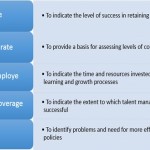Turnovers and Leveraging Data for Improving Organizational Performance

Image Source: Timon Studler | Unsplash
When used effectively, data can bring valuable improvements in all areas, including Human Resources (HR). Hugely relevant data is to be found in the area of human capital and is usually collected and managed by the HR department in your company. In essence, all organizations seek to keep top performers while reducing the number of low performers as much as possible. The first thing that comes to mind when discussing measurement in the HR area is the Turnover Rate.
Turnover Rate is a common organizational measurement that tracks the loss of talent in the workforce over time, and it may also be used to gauge an organization’s culture. Employee turnover encompasses resignations, layoffs, terminations, retirements, relocation transfers, and even deaths. Businesses frequently measure their employee turnover rate to estimate its impact on production, customer service, and even morale. Turnover is frequently referenced negatively, owing to its high expense of replacing personnel; however, it is a natural part of the employee life cycle and organizational renewal.
Now, how can data be used for maximum insight from employee turnover?
- Gather internal HR data.
Preparing the data is always the first step. If your organization has an HR Information System (HRIS), you should be able to simply get the data and elicit the desired reports from combining different available metrics. However, if your organization does not have an HRIS, the HR department should be able to provide relevant data that can be analyzed.
The turnover data you require is the headcount of the organization, as well as the record of persons who have departed the organization: employee name, date of departure, and position should all be included in the record. If you can gather supplementary information, such as the reason for leaving, the direct manager, and so on, it will help to improve the depth of analysis.
- Document and organize the data properly.
After obtaining the turnover data, it is advised that you set up a separate storage folder for this data. It should be well-documented, including periodic details (e.g. for the year 2021). With a well-structured document system, you will be able to access it and even repeat the procedure for the next period.
- Run the analysis of data at various levels of granularity.
This stage is dependent on the data you have available as well as your objective. The number of separations and headcount are the most vital components in calculating the Turnover Rate. The number of departures divided by the average employee headcount is a typical formula for calculating the turnover rate.
If your data is much more detailed, you can perform a more granular analysis, such as turnover by month and structure. This allows you to gain more specific insight rather than an overall view of the organization. Another example of granular analysis is examining the number of separations and visualizing it by using Structure. The graph will tell you whether there is a certain Structure that needs extra attention; you can also try by Manager, by age, and so on.
This is only a rough idea of how you might use your own internal data to enhance your organization’s retention and engagement. The possibilities for expanding the turnover analysis are limitless. A genuinely effective, high-value data initiative, on the other hand, requires a comprehension of data dynamics as well as how to apply today’s best practices to carefully utilize and assess data.

Tags: Employee Turnover, Human Resources, Turnover Rate





